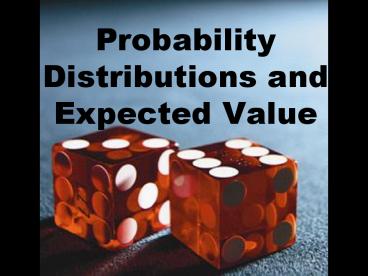Probability Distributions and Expected Value - PowerPoint PPT Presentation
1 / 18
Title:
Probability Distributions and Expected Value
Description:
In previous chapters, our emphasis was on the probability of individual outcomes. This chapter develops models for distributions that show the probabilities for ... – PowerPoint PPT presentation
Number of Views:44
Avg rating:3.0/5.0
Title: Probability Distributions and Expected Value
1
Probability Distributions and Expected Value
2
- In previous chapters, our emphasis was on the
probability of individual outcomes. - This chapter develops models for distributions
that show the probabilities for all possible
outcomes of an experiment.
3
Random Variable (X)
- Has a single value, x, for each outcome of an
experiment. - To show all the possible outcomes, a chart is
normally used.
4
Discrete variables take values that are separate
(or that can be counted)Continuous variables
have an infinite number of possible outcomes
(usually measurements that can have an unlimited
decimal place)
5
For example
- The number of phone calls made by a salesperson
- Discrete (1,2,3,4,5..)
6
For example
- The length of time a person spends on the phone
- Continuous (1 min, 1.23min ..)
7
Let a DRV (X) be the possible outcomes when
rolling a die
- The probability distribution could be written in
a table
This is a uniform distribution, because all the
probabilities are the same.
8
A graph would look like this
1/6
- 1
2
3
4
5
6
9
Remember the PD for the sums generated by rolling
2 dice?
- 7
10
Expected Value Informal
- When rolling 2 dice, the sum that is generated
most frequently is called the expected value. (7) - This can also be calculated mathematically.
- Multiply each roll by its probability of
occuring
11
- E(sum) 2P(sum 2) 3P(sum 3)
- 12P(sum 12)
- 2 X 1 / 36 3 X 2 / 36
- 252 / 36
- 7
12
The expected value, E(X), is the predicted
average of all possible outcomes.It is equal to
the sum of the products of each outcome with its
probability
13
Expected Value of a Discrete Random Variable
- The sum of the terms of the form (X)(PX)
E(X) x1P(X x1) x2P(X x2) xnP(X
xn)
14
Ex 1 Suppose you toss 3 coins.
- What is the likelihood that you would observe at
least two heads? - What is the expected number of heads?
15
Represent the theoretical probability
distribution as a table. The DRV, X, represents
the number of heads observed.
- X 0 hs 1 hs 2 hs 3 hs
P(X) x
16
- a) P(X 2) P(X 3) 3 / 8 1 / 8
- 1 / 2
- b) The expected number of heads
- 0(1 / 8) 1(3 / 8) 2(3 / 8) 3(1 / 8)
- 3 / 2
17
For a game to be fair, E(X) must be zero Consider
a dice game
- If you roll a 1 2 3 you win 1.00
- If you roll a 4 5 6 you pay 1.00
- Is this game fair?
- E(X) (1)(1/6) (1)(1/6) (1)(1/6) (-1)(1/6)
(-1)(1/6) (-1)(1/6)
18
- Page 374
- 1, 2(ex 2), 3a,c, 4, 9, 11,12, 19































